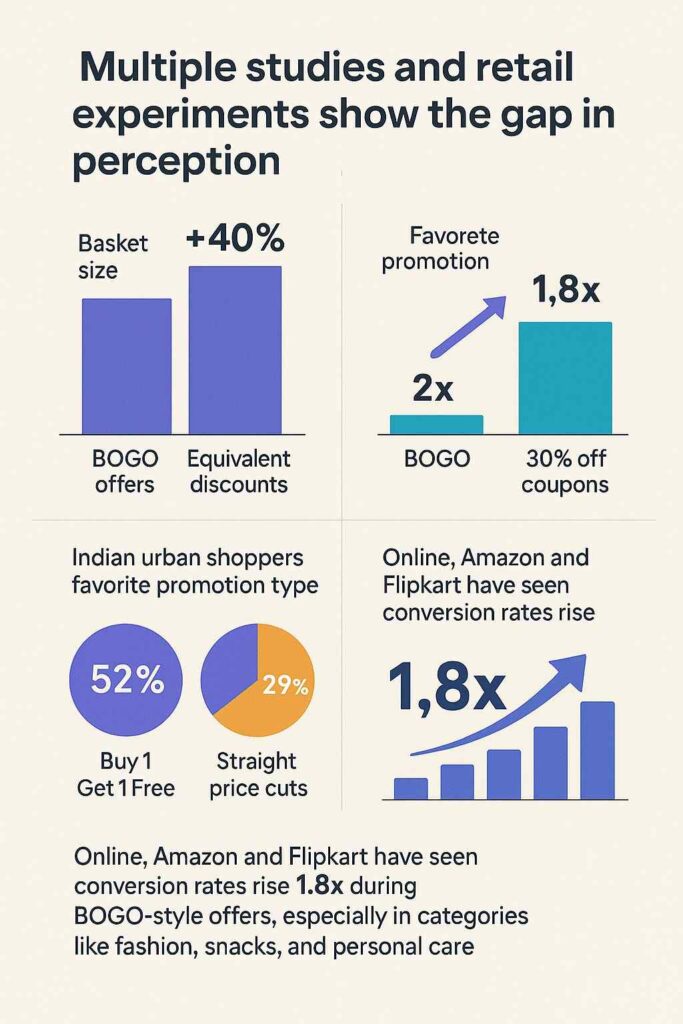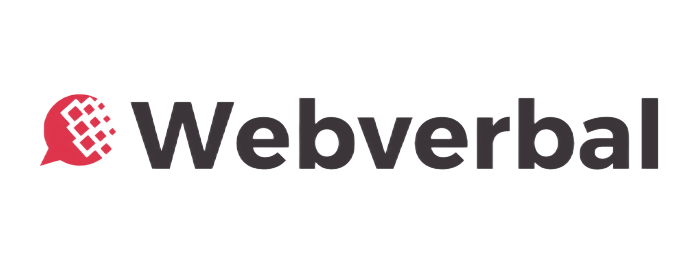Table Of Content
- The BOGO Obsession
- The Data: How Indians React to BOGO vs Discounts
- The Psychology Behind BOGO
- 1. The Zero Price Effect
- 2. Tangible Gain Over Abstract Saving
- 3. Loss Aversion and Scarcity
- 4. Social Signaling
- Why BOGO Works Especially Well in India
- 1. Price-Sensitive Culture
- 2. Household Economics
- 3. Trust Deficit in Discounts
- 4. Festival and Gifting Culture
- Case Studies: BOGO in Action
- Fashion Retailers
- FMCG
- E-commerce
- D2C Brands
- The Retailer’s Perspective: Why BOGO Is Smarter Than Discounts
- The Pitfalls of BOGO
- Why Discounts Still Have a Place
- The Future of BOGO in India
- Key Takeaways
- Founder’s Closing Lens
- FAQs
The BOGO Obsession
Walk into any Indian mall, scroll through Flipkart during festive season, or even visit your local kirana store during clearance — one phrase pops out more than any other: Buy 1 Get 1 Free.
Not “30% off.” Not “Flat ₹200 discount.”
It’s the humble BOGO that makes Indian consumers light up.
Behavioral economists call it the “zero price effect.” Marketers call it a hack. But in India, BOGO isn’t just a marketing gimmick. It’s a cultural, psychological, and behavioral phenomenon that retailers from street markets to multinational giants leverage to drive sales.
The question is: why does India love BOGO so much more than plain discounts?
The Data: How Indians React to BOGO vs Discounts

Multiple studies and retail experiments show the gap in perception:
- In retail trials, BOGO offers increased basket size by 40%, compared to just 20% for equivalent discounts.
- In FMCG categories, BOGO drives 2x faster off-take compared to 30% off coupons.
- A Nielsen report found that 52% of Indian urban shoppers rated “Buy 1 Get 1 Free” as their favorite promotion type, compared to just 29% for straight price cuts.
- Online, Amazon and Flipkart have seen conversion rates rise 1.8x during BOGO-style offers, especially in categories like fashion, snacks, and personal care.
The numbers are clear: while discounts may appeal to rational calculation, BOGO activates the emotional brain.
The Psychology Behind BOGO
Why do Indians perceive BOGO as better value? The answer lies in behavioral economics.
1. The Zero Price Effect
When something is “free,” consumers irrationally overvalue it. A ₹500 shirt at 50% off feels like a saving. But two ₹500 shirts for the price of one? That feels like a win — because the brain anchors to the word “free.”
2. Tangible Gain Over Abstract Saving
Discounts are abstract — you save money but don’t “see” it. BOGO is tangible — you hold two items instead of one. For Indian shoppers who love physical value, the second product in hand is proof that they “gained.”
3. Loss Aversion and Scarcity
If everyone else is grabbing two, buying just one feels like a loss. Indians hate missing out on value, and BOGO triggers urgency.
4. Social Signaling
Carrying two packs of chips or two bottles of shampoo communicates savvy shopping. In a culture where word-of-mouth is strong, BOGO deals become stories people share.
When something is “free,” consumers irrationally overvalue it. A ₹500 shirt at 50% off feels like a saving. But two ₹500 shirts for the price of one? That feels like a win — because the brain anchors to the word “free.” Behavioral economists have documented this extensively, as highlighted in Harvard Business Review’s analysis on the psychology of discounts.
Why BOGO Works Especially Well in India
1. Price-Sensitive Culture
Indians negotiate over ₹5 with the sabziwala. Value is always relative. BOGO offers double the product at the same price, which feels more rewarding than a simple reduction in MRP.
2. Household Economics
Indian families shop in bulk. BOGO suits family consumption patterns, where two shampoos, two biscuit packs, or two kurtas will eventually be used. Discounts often appeal to individual buyers, but BOGO feels like a household win.
3. Trust Deficit in Discounts
Many Indian consumers distrust MRP-based discounts (“Was this inflated before the sale?”). But BOGO feels transparent: pay for one, get one more. No hidden math.
4. Festival and Gifting Culture
Festivals amplify BOGO psychology. Buying sweets, clothes, or cosmetics in twos aligns with gifting. A Diwali pack that says “Buy 1 Get 1” fits cultural habits better than “Flat 25% off.”
Case Studies: BOGO in Action
Fashion Retailers
During End-of-Season sales, brands like Pantaloons and Lifestyle push BOGO racks upfront. Shoppers crowd them before 50% off racks, because two shirts in hand feel better than one shirt at half price.
FMCG
Biscuits, chips, soaps, and shampoos are classic BOGO categories. ITC and HUL use “100% extra free” as a variation — consumers perceive extra grams as a win, not just a cut price.
E-commerce
Flipkart’s “Buy 2 Get 2 Free” on fashion accessories consistently outperforms discount-led promotions. Amazon’s combo packs in groceries follow the same playbook.
D2C Brands
PEP Technologies’ mCaffeine ran BOGO campaigns during festive launches. As I analyzed in The Complete Guide to Pricing Psychology in India, bundling value perception with brand storytelling helped the brand stand out in crowded categories.
The Retailer’s Perspective: Why BOGO Is Smarter Than Discounts
From a business point of view, BOGO isn’t always as generous as it looks.
- Inventory Clearance: BOGO helps retailers clear old stock faster than discounts.
- Perceived Value: Consumers think they’re getting double, but margins often allow it in FMCG and apparel.
- Basket Expansion: BOGO pushes consumers to buy more volume than they intended.
- Loyalty Hack: Even if customers don’t need two, they’re less likely to switch brands after stocking up.
For brands, BOGO is a psychology-first pricing strategy.
The Pitfalls of BOGO
Of course, BOGO isn’t a silver bullet.
- Stockpiling Behavior
Consumers buy more than they need, which may delay repeat purchases. Retailers see short-term spikes but long gaps after. - Margin Pressure
For small D2C brands, BOGO can burn margins. Unlike large FMCG players, they lack scale to absorb costs. - Unsustainable Expectations
Once trained on BOGO, consumers may resist paying full price. Overuse risks turning BOGO into a baseline, not a bonus.
Why Discounts Still Have a Place
While BOGO dominates in certain categories, discounts work better in others:
- Electronics: Consumers calculate absolute rupee savings. ₹5,000 off feels bigger than a “free” second laptop.
- Luxury: Premium buyers don’t want two of the same. Discounts feel more dignified.
- Services: SaaS subscriptions, gym memberships, and courses rely on monetary discounts rather than tangible duplication.
The key is alignment: BOGO works where products are consumable, repeatable, and bulk-friendly. Discounts work where price clarity matters.
The Future of BOGO in India
As India’s middle class expands, BOGO will continue to thrive in FMCG, fashion, and festive shopping. But smart brands will evolve beyond “plain BOGO” to innovative bundles:
- Buy 2 Get 1 (for premium positioning).
- Cross-category BOGO (buy shampoo, get conditioner free).
- Digital BOGO (buy a course, gift one).
E-commerce platforms will increasingly use AI to personalize promotions: BOGO for families, discounts for singles.
The psychology, however, will remain the same: Indians love seeing tangible value.
Key Takeaways
- BOGO works better than discounts in India because of psychology (free effect), culture (bulk/gifting), and trust (clear value).
- Retailers prefer BOGO because it moves inventory faster, boosts basket size, and drives loyalty.
- Risks include margin strain, stockpiling, and consumer over-expectation.
- Smart brands use BOGO selectively, aligned with product type and consumer context.
Founder’s Closing Lens
As a founder and observer of India’s consumer economy, I see BOGO as more than a promotion tactic. It’s a mirror of how Indians think about value.
In Bharat, a ₹200 discount feels abstract. But an extra ₹200 product in hand feels real. That’s why BOGO resonates — it aligns perfectly with a culture that values tangible gain, household economics, and the joy of “something extra.”
For founders building D2C brands, the lesson is clear: don’t just chase discounts. Design promotions that speak to behavior, not just price. BOGO isn’t a gimmick — it’s a psychological bridge to consumer trust.
FAQs
Because BOGO creates tangible value, feels more transparent than discounts, and fits cultural patterns of bulk buying and gifting.
Often yes. Retailers clear inventory faster, expand baskets, and build loyalty. Margins are managed by pricing strategies and selective use.
Yes, but carefully. Overuse can destroy margins. Smart bundling and festive timing help D2C brands use BOGO without burning cash.
In categories like electronics, luxury goods, or services, where absolute price savings matter more than duplicate products.




